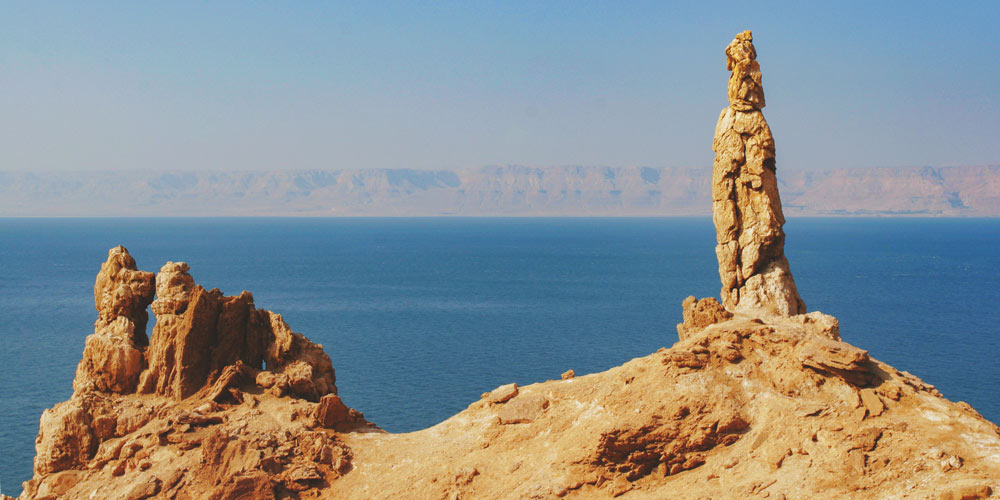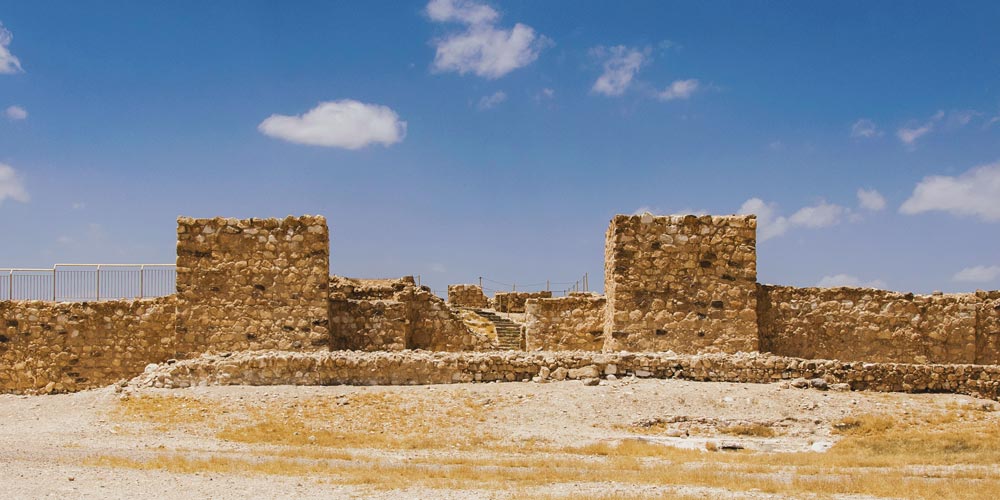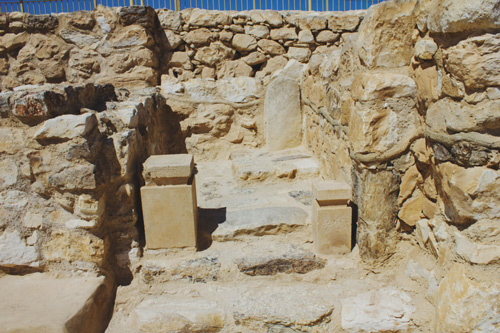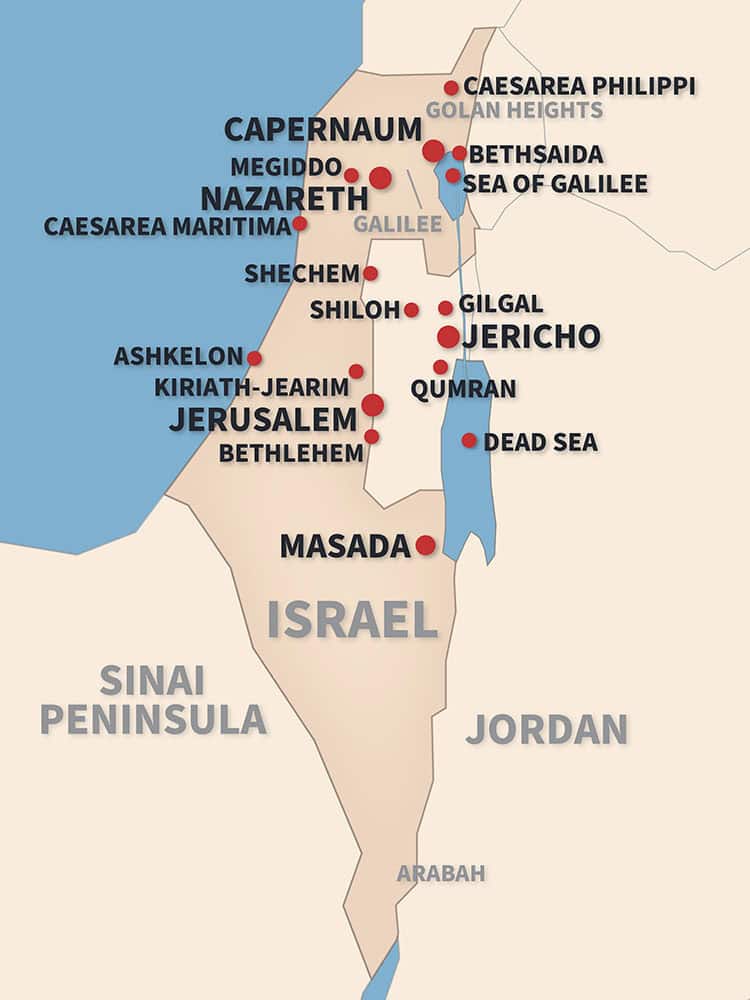Judgment of God in Ancient Israel and Jordan
By Jennifer Bartlett

Why would someone want to travel to ancient ruins in Israel and Jordan? On a Biblical tour of the Holy Land, Christians usually want to explore the places associated with Jesus’ miracles; to retrace the steps of our Lord, through whom God’s mercy was poured out into the world. We tend to associate these places with God’s favor and blessings. But there are locations tied to the Judgment of God and His wrath in ancient Israel, as well. Considering scenes where God condemned the practices of violence, immorality, and idolatry may enable us to appreciate His mercy all the more! On a biblical tour of Israel and Jordan, find out how the sites of Sodom and Arad point to God’s perfect justice.
For many years, people have speculated about the location of these sister cities, and now, evidence seems to confirm that the city of Tall el-Hammam was once the biblical city of Sodom. Those interested in the biblical archeology can now view the ancient site during a tour to Israel and Jordan. Guests will even be able to view the pillar that is believed to be Lot’s wife!
Judgment of God in Ancient Jordan: Biblical Sodom
One of the most well-known examples of the Judgment of God and His wrath in the Bible is the story of His judgment on the cities of Sodom and Gomorrah. The Lord and his two angels visited Abraham, and then traveled to Sodom to destroy the city because of the evil ways of its people. Genesis 13:13 describes them this way: “Now the men of Sodom were wicked, great sinners against the LORD.” The story that unfolds in Genesis 19 rather politely describes a sexually immoral practice the Sodomites were engaged in that warranted God’s swift and severe judgment.
What Sexual Practice Brought God’s Judgment on Sodom and Gomorrah?
They wanted to “know” the angels who were guests in Lot’s home (Gen.19:1-5). This doesn’t mean they wanted to merely meet these angelic men; the inhabitants of Sodom wanted to “know” them physically, to violate them. Lot pleaded with his neighbors, saying, “I beg you, my brothers, do not act so wickedly” (Gen.19:7). He clearly understood what they wanted to do, and he was trying to prevent this from happening.
What Happened to the Residents of Sodom and Gomorrah?
As the story continues, the angels caused blindness to fall on these evil men until Lot and his family could be led safely out of the city, and then God’s wrath fell on the cities of the plain (Gen.19:16-29). The angels sternly warned them not to look back, but Lot’s wife disobeyed this command, and she became a pillar of salt (Gen.19:26).
Evidence That Modern-Day Tall el-Hammam is Ancient Sodom:
During the excavation of Tall el-Hammam, Minoan pottery was discovered. The Minoan culture had a custom in which older men would abduct young boys and abuse them sexually as a type of right-of-passage. Although the research is ongoing, it is possible that those in Sodom may have observed a similar practice.
Scorched Remains
Excavators also discovered evidence of what may have been a meteor explosion. Reports include the finding of Trinitite (glasslike substances formed from the melting of sand) on the back of a pottery shard, as well as one-half meter of thick, dark ash surrounding the gate area, and scattered human bones that suggest the people of Tall el-Hammam did not die peacefully. A meteor of this magnitude would potentially create a vortex, or a whirling mass of fire, causing matter to be thrown into the air and then to rain back down to land. Genesis 19:24, 27-28 states:
Then the LORD rained on Sodom and Gomorrah sulfur and fire from the LORD out of heaven…And Abraham went early in the morning to the place where he had stood before the LORD. And he looked down toward Sodom and Gomorrah and toward all the land of the valley, and he looked and, behold, the smoke of the land went up like the smoke of a furnace.
(Gen.19:24, 27-28)
The massive explosion could also explain how Lot’s wife became a pillar of salt. As the group fled the city along the shore of the Dead Sea—the saltiest body of water on earth—the impact of the explosion could have caused the surrounding land to be coated with a thick layer of salt. The hesitation of Lot’s wife would have rendered her a pillar of salt.
Consistent Geography Described in the Bible
Finally, there is geographical evidence that is consistent with Genesis 13:10, which says, “And Lot lifted up his eyes and saw that the Jordan Valley was well watered everywhere like the garden of the LORD…”
The word that is here translated “valley” is kikkar in Hebrew, which refers to something round, like a disk,
“Round: hence 1. a round district. 2. a round loaf. 3. a round weight, talent.” (Francis Brown, Samuel Rolles Driver, and Charles Augustus Briggs, Enhanced Brown-Driver-Briggs Hebrew and English Lexicon [Oxford: Clarendon Press, 1977], 503).
and the excavation site literally looks like a disk. Additionally, the location of Sodom must match the biblical description. In Genesis 13:3, when Abraham and Lot are discussing how they will divide the land when they separate, they are between Bethel and Ai. Verse 11 says, “So Lot chose for himself all the Jordan Valley, and Lot journeyed east. Thus they separated from each other.”(Gen.13:11) By starting at Bethel/Ai and traveling to the eastern end of the kikkar disk, we would arrive at Tall el-Hammam.
The evidence we’ve gained from the Minoan pottery, meteor blast, and details of the geographical location all points to Tall el-Hammam as the site of one of the infamous cities of the plain of the Jordan, likely Sodom, where Lot himself lived. The findings of the excavations seem to closely match the biblical account and point to its validity.

The Judgment of God in Ancient Israel: The Temple at Tel-Arad
As Bible enthusiasts and history buffs flock to biblical sites, one that is lesser known is the temple at Tel-Arad. This is likely because it made only a brief appearance in Scripture.
Location of Arad
Arad is a city in Israel, south of Jerusalem, on the border of the Negev and Judean Deserts. Tel-Arad lies five miles west of the modern city. It affords visitors a fascinating look at the ruins of an ancient temple, a darker chapter in the Israelites’ journey of faith, which can be explored on our authentic Israel tours.
God Gives the Israelites the Land of Arad
Toward the end of the Wilderness Wanderings, just after Moses’ brother Aaron had died, the king of Arad and his people attacked the Israelites, who then sought the Lord, promising that if He would deliver the people of Arad into their hands, they would destroy their cities (Num. 21:1-2). Verse 3 says, “And the LORD heeded the voice of Israel and gave over the Canaanites, and they devoted them and their cities to destruction. So the name of the place was called Hormah.”(Num. 21:3)
An Idolatrous Temple at Arad from the Time of Solomon
After the Israelites settled into their new land, “the whole congregation of the people of Israel assembled at Shiloh and set up the tent of meeting there. The land lay subdued before them.” (Josh. 18:1) Archaeologist Scott Stripling notes that the tabernacle stood at Shiloh for over 300 years.
Solomon’s temple, which was built in 966 BC,
Scott Stripling, The Trowel and the Truth: A Guide to Field Archaeology in the Holy Land (Kindle Location 971). Vision Publishing. Kindle Edition.
was the only temple the Israelites were supposed to use to worship God. However,
when Solomon was old his wives turned away his heart after other gods, and his heart was not wholly true to the LORD his God, as was the heart of David his father. For Solomon went after Ashtoreth the goddess of the Sidonians, and after Milcom the abomination of the Ammonites. So Solomon did what was evil in the sight of the LORD and did not wholly follow the LORD, as David his father had done. Then Solomon built a high place for Chemosh the abomination of Moab, and for Molech the abomination of the Ammonites, on the mountain east of Jerusalem. And so he did for all his foreign wives, who made offerings and sacrificed to their gods.
(1 Kings 11:4-8)
Israel Divided
This idolatry led to the division of the kingdom of Israel under Solomon’s son, Rehoboam. While the faithful in the southern kingdom of Judah continued worshiping at the temple in Jerusalem, King Jeroboam of the northern kingdom of Israel established alternate sites of worship in both the north and south:
So the king took counsel and made two calves of gold. And he said to the people, “You have gone up to Jerusalem long enough. Behold your gods, O Israel, who brought you up out of the land of Egypt.” 29 And he set one in Bethel, and the other he put in Dan. (1 Kings 12:28-29)
Intermingled Worship

It is not clear who authorized the building of the temple at Tel Arad, but here you can see the ruins of this complete temple, which dates to the 10th century BC,
according to the excavation report by Yohanan Aharoni.
Yohanan Aharoni, “Arad: Its Inscriptions and Temple,” The Biblical Archaeologist Vol. 31, No. 1 (Feb., 1968), p. 19.
It consists of two main rooms: the Holy place with a wide layout similar to Jeroboam’s temple in Tel-Dan, and a smaller square room, which was the holy of holies. Here stand two upright stones. It is believed that one represents Yahweh and the other, the goddess Ashtoreth. This supports the biblical account that the Israelites, including Solomon, began to mingle pagan worship with the worship of the true God, a practice God Himself condemned and for which He promised judgment and destruction.
Pagan Worship Sites Destroyed
It is thought that the temple at Tel-Arad was covered over in the 8th century BC, during King Hezekiah’s reign. A faithful follower of God, Hezekiah ordered the destruction of all high places except for the Jerusalem’s temple.
In the third year of Hoshea son of Elah, king of Israel, Hezekiah the son of Ahaz, king of Judah, began to reign. He was twenty-five years old when he began to reign, and he reigned twenty-nine years in Jerusalem. His mother’s name was Abi the daughter of Zechariah. And he did what was right in the eyes of the LORD, according to all that David his father had done. He removed the high places and broke the pillars and cut down the Asherah…(2 Kings 18:1-4)
Because of Hezekiah’s faithfulness, God spared him and Jerusalem from the onslaught of the Assyrians. The northern kingdom, however, had no faithful kings; they all worshiped foreign gods. The Assyrians destroyed their cities, killed countless Israelites, and scattered the survivors throughout other territories. However, after the reign of Hezekiah, idolatry returned to the southern kingdom as well.
Arad Repaired
The temple at Arad appears to have undergone repairs at various intervals since it was built, suggesting that it may have been at least partially destroyed on more than one occasion. Whether this was done by enemies who were attacking Israel, or from within, during periods of reform, remains a mystery.
Aharoni notes that although there were “alterations in the plan of the sacred building…great pains were taken to preserve the old, traditional structure,” and “the altar, too, was always rebuilt on the same spot.”
Yohanan Aharoni, “Arad: Its Inscriptions and Temple,” The Biblical Archaeologist Vol. 31, No. 1 (Feb., 1968), p. 23.
Babylonian Destruction
The Southern kingdom fell to the Babylonians in 587 BC, who completely destroyed the temple that had once been used to worship the one true God in Jerusalem. When God brought them back into their land, they seem to have learned their lesson, because there doesn’t seem to be any evidence of idolatry being practiced in Israel after this time.
God is Faithful
The temple at Tel-Arad is a fascinating ancient temple, which was very likely used in the worship of at least one deity other than Yahweh. God is no respecter of persons, and His holiness demands the punishment of sin. Sites that demonstrate God’s judgment, such as the temple of Arad and the ruins of Tall el-Hammam serve as a reminder that God wants whole-hearted worship. He is faithful to accomplish His word, and He is glorified in acts of judgment as well as through acts of mercy.
Visit these and other fascinating biblical sites on a Christian tour to Israel through Living Passages.




